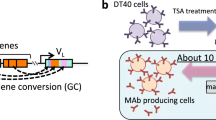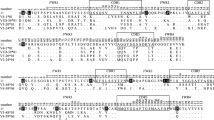Abstract
Antibody catalysis1 provides an opportunity to examine the evolution of binding energy and its relation to catalytic function in a system that has many parallels with natural enzymes. Here we report such a study involving an antibody AZ-28 that catalyses an oxy-Cope rearrangement, a pericyclic reaction that belongs to a well studied and widely used class of reactions in organic chemistry2. Immunization with transition state analogue 1 results in a germline-encoded antibody that catalyses the rearrangement of hexadiene 2 to aldehyde 3 with a rate approaching that of a related pericyclic reaction catalysed by the enzyme chorismate mutase3. Affinity maturation gives antibody AZ-28, which has six amino acid substitutions, one of which results in a decrease in catalytic rate. To understand the relationship between binding and catalytic rate in this system we characterized a series of active-site mutants and determined the three-dimensional crystal structure of the complex of AZ-28 with the transition state analogue. This analysis indicates that the activation energy depends on a complex balance of several stereoelectronic effects which are controlled by an extensive network of binding interactions in the active site. Thus in this instance the combinatorial diversity of the immune system provided both an efficient catalyst for a reaction where no enzyme is known, as well as an opportunity to explore the mechanisms and evolution of biological catalysis.
This is a preview of subscription content, access via your institution
Access options
Subscribe to this journal
Receive 51 print issues and online access
$199.00 per year
only $3.90 per issue
Buy this article
- Purchase on Springer Link
- Instant access to full article PDF
Prices may be subject to local taxes which are calculated during checkout




Similar content being viewed by others
References
Schultz, P. G. & Lerner, R. A. From molecular diversity to catalysis: lessons from the immune system. Science 269, 1835–1842 (1995).
Woodward, R. B. & Hoffmann, R. The Conservation of Orbital Symmetry(Academic, New York, (1970).
Andrews, P. R., Smith, G. D. & Young, I. G. Transition-state stabilization and enzymic catalysis. Kinetic and molecular orbital studies of the rearrangement of chorismate to prephenate. Biochemistry 12, 3492–3498 (1973).
Braisted, A. C. & Schultz, P. G. An antibody-catalyzed oxy-Cope rearrangement. J. Am. Chem. Soc. 116, 2211–2212 (1994).
Ulrich, H. D., Patten, P. A., Yang, P. L., Romesberg, F. E. & Schultz, P. G. Expression studies of catalytic antibodies. Proc. Natl Acad. Sci. USA 92, 11907–11911 (1995).
Ulrich, H. D., Driggers, E. M. & Schultz, P. G. Antibody catalysis of pericyclic reactions. Acta Chem. Scand. 50, 328–332 (1996).
Pech, M., Höchtl, J., Schell, H. & Zachau, H. G. Differences between germ-line and rearranged imunoglobulin Vκ coding sequences suggest a localized mutation mechanism. Nature 291, 668–670 (1981).
Akolkar, P. N.et al. Different VLand VHgermline genes are used to produce similar combining sites with specificity for α(1 → 6) dextrans. J. Immunol. 138, 4472–4470 (1987).
Kurosawa, Y. & Tonegawa, S. Organization, structure, and assembly of immunoglobulin heavy chain diversity DNA segments. J. Exp. Med. 155, 201–218 (1982).
Patten, P. A. et al. The immunological evolution of catalysis. Science 271, 1086–1091 (1996).
Berek, C., Griffiths, G. M. & Milstein, C. Molecular events during maturation of the immune response to oxazolone. Nature 316, 412–418 (1985).
Haldane, J. B. S. Enzymes(Longmans, Green&Co., London, (1930).
Pauling, L. Chem. Eng. News 24, 1375 (1946).
Driggers, E. M. et al. Mechanistic studies of an antibody-catalyzed oxy-Cope rearrangement. J. Am. Chem. Soc. (submitted).
Ulrich, H. Recombinant catalytic antibodies. thesis, Univ. California, Berkeley, (1996).
Page, M. I. & Jencks, W. P. Entropic contributions to rate accelerations in enzymic intramolecular reactions and the chelate effect. Proc. Natl Acad. Sci. USA 68, 1678–1683 (1971).
Doering, W. v. E. & Roth, W. R. The overlap of two allyl radicals or a four-centered transition state in the Cope rearrangement. Tetrahedron 18, 67–74 (1962).
Gajewski, J. J. Energy surfaces of sigmatropic shifts. Acct. Chem. Res. 13, 142–148 (1980).
Gajewski, J. J. & Gee, K. R. Solvent, counterion, and secondary deuterium kinetic isotope effects in the anionic oxy-Cope rearrangement. J. Am. Chem. Soc. 113, 967–971 (1991).
Steigerwald, M. J., Goddard, W. A. & Evens, D. A. Theoretical studies of the oxy-anionic substituent effect. J. Am. Chem. Soc. 101, 1994–1997 (1979).
Dewar, M. J. S. & Wade, L. E. Astudy of the mechanism of the cope rearrangement. J. Am. Chem. Soc. 99, 4417–4424 (1977).
Ulrich, H. D. & Schultz, P. G. The evolution of binding affinity and catalysis in a family of catalytic antibodies. J. Mol. Biol. (submitted).
Storm, D. R. & Koshland, D. E. J Asource for the special catalytic power of enzymes: Orbital steering. Proc. Natl Acad. Sci. USA 66, 445–452 (1970).
Janda, K. D. et al. Direct selection for a catalytic mechanism from combinatorial antibody libraries. Proc. Natl Acad. Sci. USA 91, 2532–2536 (1994).
Tawfik, D. S., Green, B. S., Chap, R., Sela, M. & Eshhar, Z. catELISA: A facile general route to catalytic antibodies. Proc. Natl Acad. Sci. USA 90, 373–377 (1993).
Kabat, E. A., Wu, T. T., Perry, H. M., Gottesman, K. S. & Foeller, C. Sequences of Proteins of Immunological Interest(US Dept of Health and Human Services, National Institutions of Health, Bethesda, (1991).
Nahmias, C., Strosberg, A. D. & Emorine, L. J. The immune response toward β-adrenergic ligands their receptors. VIII. Extensive diversity of VHand VLgenes encoding anti-alprenolol antibodies. J. Immunol. 140, 1304–1311 (1988).
Otwinowski, Z. & Minor, W. Processing of X-ray diffraction data collected in oscillation mode. Meth. Enzymol. 276, 307–325 (1996).
Navaza, J. AMoRe: An automated package for molecular replacement. Acta Crystallogr. A 50, 157–163 (1994).
Strong, R. K. et al. Three-dimensional structure of a murine anti-P-azophenylarsonate FAB 36-71. 1. X-ray crystallography, site-directed mutagenesis, and modeling of the Complex with hapten. Biochemistry 30, 3739–3748 (1991).
Jones, T. A., Zou, J.-Y., Cowan, S. W. & Kjeldgaard, M. Improved methods for building protein models in electron density maps and the location of errors in these models. Acta Crystallogr. A 47, 110–119 (1991).
Brunger, A. X-PLOR, Version 3.851. A System for X-ray Crystallography and NMR(Yale Univ. Press, New Haven, Connecticut, (1996).
Collaborative Computational Project Number 4. The CCP4 suite: Programs for protein crystallography. Acta Crystallogr. D 50, 760–763 (1994).
Acknowledgements
We thank M. Conn for precursor to the hapten, C. Cho and P. Yang for helpful discussions, and the Stanford Synchrotron Radiation Laboratory for synchrotron beam time. We are grateful for financial support for this work from the US Department of Energy and the NIH. P.G.S. is a HHMI investigator; H.D.U. was supported by a predoctoral fellowship from the NSF.
Author information
Authors and Affiliations
Rights and permissions
About this article
Cite this article
Ulrich, H., Mundorff, E., Santarsiero, B. et al. The interplay between binding energy and catalysis in the evolution of a catalytic antibody. Nature 389, 271–275 (1997). https://doi.org/10.1038/38470
Received:
Accepted:
Issue Date:
DOI: https://doi.org/10.1038/38470
This article is cited by
-
Theoretical QM/MM studies of enzymatic pericyclic reactions
Interdisciplinary Sciences: Computational Life Sciences (2010)
-
How T cells 'see' antigen
Nature Immunology (2005)
-
In vitro abzyme evolution to optimize antibody recognition for catalysis
Nature Biotechnology (2001)
Comments
By submitting a comment you agree to abide by our Terms and Community Guidelines. If you find something abusive or that does not comply with our terms or guidelines please flag it as inappropriate.



